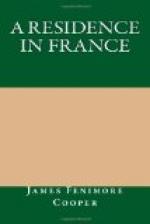If you remember the satisfaction with which we visited the little hunting-tower of the poor Prince de Conde in 1827, a building whose chief merit was its outward form and the fact that it had been built by the Queen Blanche, you can form some notion of the zeal with which we toiled up the steep ascent, on the present occasion. The path was good, tasteful, and sinuous; but the buildings stood on crags that were almost perpendicular on three of their sides, and at an elevation of near, or perhaps quite, two hundred feet above the road.
We were greeted, on reaching the gate, not by a warder, but by the growl and bark of a ferocious mastiff, who would have been more in keeping at his post near a henroost, than at the portal of a princely castle. One “half-groom, half-seneschal,” and who was withal a little drunk, however, soon came forth to receive us, and, after an exhortation to the dog in a Dutch that was not quite as sonorous as the growl of the animal, he very civilly offered to do the honours of the place.
We entered by a small drawbridge, but the buildings stand so near the brow of an impending rock, as to induce me to think this bridge has been made for effect, rather than to renew the original design. A good deal of the old wall remains, especially in the towers, which are mostly round, and all that has been done with the exterior, has been to fill the gaps, and to re-attach the balconies and the external staircases, which are of iron. I can no more give you a clear idea of the irregular form of this edifice with the pen, than you would obtain of the intricate tracery of Gothic architecture, having never seen a Gothic edifice, or studied a treatise on the style, by the same means. You will understand the difficulty when you are told that this castle is built on crags, whose broken summits are its foundations, and give it its form. The court is narrow and inconvenient, carriages never approaching it, but several pretty little terraces in front answer most of the purposes of courts, and command lovely glimpses of the Rhine, in both directions. These terraces, like the towers and walls, were placed just where there was room, and the total absence of regularity forms one of the charms of the place.
In the interior, the ancient arrangement has been studiously respected. The furniture is more than imitation, for we were told that much of it had been taken from the royal collections of Berlin. By royal, you are not to suppose, however, that there are any attempts at royal state, but merely that the old castles of the barons and counts, whose diminutive territories have contributed to rear the modern state of Prussia, have been ransacked for this end.




